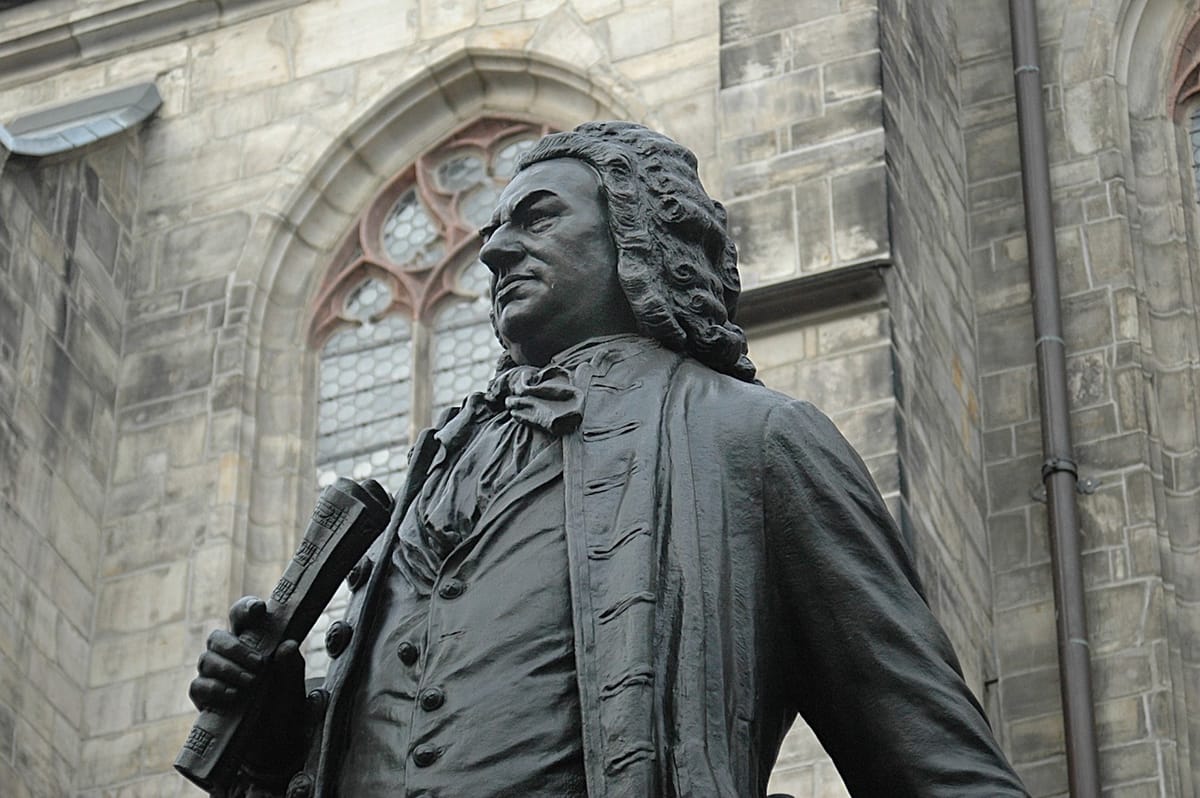Bach-tracking

Johann Sebastian Bach (1685-1750) seems to sneak up on me in the unlikeliest of places. I‘m not much of a Netflixer, and tend to watch episodes of series very erratically, often with weeks to months in between. One such series is ‘Outlander’, based on the eponymous historical fiction novel series by Diana Gabaldon. Its basic premise is time travel, the lead protagonist transported back in time from the 20th century (soon after WWII) England back several centuries, to 1743 Scotland, and finds herself embroiled in the Jacobite uprising. Only she knows what a disaster it will turn out to be. Can she prevent the inevitable?
There’s needless graphic depiction of cruelty and torture scenes, which is why it’s difficult to binge-watch. But I appreciate the candour with which today’s United Kingdom is able to look at its own past. I can’t imagine a similar warts-and-all examination of our country’s past, even in historical fiction. What we have here instead is distortion and jingoism.
In one episode (in series 2), Bach’s music appears in Paris as a cipher in a letter, a secret message sent through the alteration of his Goldberg Variations. The additions of sharps and flats dictate which word from the beginning or end of the text is to be read as part of the secret message. It’s something that would probably have appealed to Bach, who used ciphers in his own music.
The nun in the story who helps unravel the cipher is (conveniently) a friend of Bach, and calls him “a little old German” and thinks “his music is not the sort to endure; clever but no heart. Hmph!” Even the casual reader of the book series, or watcher of the film adaptation will know how wrong Sister Hildegarde was.
Sometimes Bach turns up in more expected settings, as he did during the recently concluded week-long music camp for young people held at our Child’s Play premises by musicians of the Symphony Orchestra of India (SOI) based at the National Centre for the Performing Arts (NCPA) Mumbai, the first of its kind, and I hope the first of many more collaborations with the SOI/NCPA in Goa.
A participant chose as her individual study piece a melody that we know popularly as the ‘Air on the G string’, which is in fact an arrangement of the second movement (“Air”) of Bach’s Orchestral Suite No. 3 in D major, BWV 1068.
How and why did a work in D major acquire the title ‘Air on the G string’? It is because in 1871, German violinist and pedagogue August Wilhelmj (1845-1908) transposed the part of the first violins down to C major, so that the entire piece could be played on just the violin’s lowest string (the G string). In performance, that part is generally played by a single violin (instead of by the first violins as a group). Wilhelmj wrote “auf der G-Saite” (on the G string) above the staff for the solo violin, which gave the arrangement its nickname.
Although it entered the violin repertoire, with recordings in the beginning of the 20th century, by greats that included Fritz Kreisler, Mischa Elman, Arnold Rosé, Jacques Thibaud, Jenő Hubaay, Bronislaw Huberman, Efrem Zimbalist among many others, not everyone was a fan.
The legendary Hungarian violinist-composer, conductor and teacher Joseph Joachim (1831-1907) denounced the Wilhelmj as “a shameless falsification” of Bach’s music. The British musicologist Donald Francis Tovey (1875-1940) sniffed that at his concerts, “[the Air] will be heard as Bach wrote it, in its original D major as an angelic soprano strain, not in C major as a display of contralto depths.”
Those formidable critics notwithstanding (and one can see their point of view), the Wilhelmj arrangement did much to popularise this Bach melody. It is the reason I studied it early on in my own study of the violin. I found it very useful for control of slow bow speed, to start soft at the frog (the lower end of the bow) and build to a forte at the tip, for tone production in higher registers, and for practice of shifts and intonation in higher positions, especially the ‘even’ ones most violinists don’t use so often.
It was that sustained opening note of the melody against a descending bass line of the ‘Air on the G string’ that inspired the song ‘A Whiter Shade of Pale’ on the 1967 debut record of the English rock band Procol Harum that has now become synonymous with the group. Its composer Gary Brooker said as much in an interview to ‘Uncut’ magazine: “If you trace the chordal element, it does a bar or two of Bach’s ‘Air on a G String’ before it veers off. That spark was all it took. I wasn’t consciously combining rock with classical, it’s just that Bach’s music was in me.”
That Bach’s music was “in” him is an understatement. Apart from the “Air”, others have found “family resemblances” in his song to other Bach works: the Sinfonia which opens the cantata Ich steh mit einem Fuß im Grabe, BWV 156, the organ chorale Prelude O Mensch, bewein’ dein’ Sünde groß (O Man, Lament Your Sin So Great), BWV 622, from the Orgelbüchlein (Little Organ Book) and the Cantata Sleepers Wake, BWV140. I made the effort to listen to these other ‘inspirations’ and they are a little more distantly related than the “Air” itself.
Among the cover versions of ‘A Whiter Shade of Pale’ that I grew up listening to, Annie Lennox appeals to me.
Another song inspired by the same Bach composition, but which directly quotes the actual first four bars of the original movement from the Orchestral Suite in a sort of loop while a singer raps most of the lyrics except for the refrain, is ‘Everything’s gonna be alright’ (1997) by the German group Sweetbox.
Of course everything’s gonna be alright. It has to, if your backing track is Bach.
This article first appeared in The Navhind Times, Goa, India.





